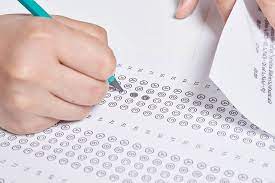Sophomores and Juniors Offered PSAT Opportunity

November 17, 2022
To high school students, the formidable ACT and SAT acronyms are all too familiar. For sophomores in particular, the looming hours of studying only draw nearer. The impending arrival of the tests has ushered in much uneasiness among the student body as preparations for the exams have certainly begun for many. One of these exams, the PSAT, the Preliminary Scholastic Aptitude Test, took place on October 15th. Sophomores and juniors were given the opportunity to gauge their abilities and earn merit scholarships. With its daunting reputation it was inevitable that discussion dispersed among THS students following the test. Was it all that bad?
The PSAT is a baseline for college readiness; it offers a way for colleges to reward student merit and for students to familiarize themselves with the exam. The test, consisting of two sections (Evidence Based Reading and Writing and Math), spans a total of two hours and 45 minutes, with two breaks in-between. Students who receive high marks are eligible for scholarships, thus making the PSAT an opportunity that many find worth seizing. Even for those who may not qualify for such scholarships, the test acts as a primer for the SAT as it mimics its structure and difficulty.
The PSAT can be a daunting measure of academic skill for some, while for others it may serve as an advantageous way to reduce stress before taking the official exam. “I was really anxious going into it, but I ultimately realized that the test was not as bad as I had previously thought,” Selah Jain (’25) said. In retrospect, despite the anxiety building up to the exam, Jain was content in her choice to take it. “It gave me a baseline and a sense of what I needed to focus on, what I’m going to have to practice,” she said. With a narrowed focus, Jain can now concentrate on improving her time management in order to better prepare for the future exams. “I need to manage my time more efficiently,” she said. “You can’t focus too long on a specific question; you have to know when to move on.” Though she struggled with time distribution, Jain is satisfied with her broadened understanding of the structure of the test.
Diana Rosen (’25) echoed Jain’s positive perspective towards participation on the primal exam. “I was able to identify my strengths and weaknesses,” she said. While she admits that the test was challenging, Rosen was happy to have familiarized herself with its new structure. Even just adapting to the procedures and the atmosphere of the test made for a beneficial experience.
For sophomores, studying for the SAT can be an overwhelming stress. But the PSAT can be a rewarding opportunity to measure one’s preparation and readiness. Though the PSAT is optional, it is recommended, by students and staff alike, to take the exam to get a feel for the test. Of course, deciding whether to take it or not is definitely a choice worth considering.

















































































































































